Impact of Climate Change on Distribution of Suitable Niches for Black Locust (Robinia pseudoacacia L.) Plantation in China
Abstract
1. Introduction
2. Materials and Methods
2.1. Spatial Distribution Records of Robinia pseudoacacia L. Plantations
2.2. Environmental Factors
2.3. The MaxEnt Model
2.4. Accuracy Test of the Model
3. Results
3.1. Key Factors Affecting the Distribution of Robinia pseudoacacia L. Plantations
3.2. Suitable Niches for Robinia pseudoacacia L. Plantations in the Current Climate
3.3. Suitable Niches for Robinia pseudoacacia L. Plantations over Past Decades
3.4. Suitable Niches for Robinia pseudoacacia L. Plantations in Future Climate Scenarios
4. Discussion
5. Conclusions
Author Contributions
Funding
Data Availability Statement
Conflicts of Interest
References
- Cierjacks, A.; Kowarik, I.; Joshi, J.; Hempel, S.; Ristow, M.; von der Lippe, M.; Weber, E. Biological Flora of the British Isles: Robinia pseudoacacia. J. Ecol. 2013, 101, 1623–1640. [Google Scholar] [CrossRef]
- Vitková, M.; Muellerová, J.; Sádlo, J.; Pergl, J.; Pysek, P. Black locust (Robinia pseudoacacia) beloved and despised: A story of an invasive tree in Central Europe. For. Ecol. Manag. 2017, 384, 287–302. [Google Scholar] [CrossRef] [PubMed]
- Yan, X.Y.; Zhang, Z.D.; Huang, M.B.; Zhao, X.F.; Yang, F.; Wu, X.F. The impact of climate change on growth and drought-induced mortality risk of Robinia pseudoacacia plantations along a precipitation gradient on the Chinese Loess Plateau. Agric. For. Meteorol. 2022, 325, 109160. [Google Scholar] [CrossRef]
- Chen, P.D.; Hou, Y.P.; Zhuge, Y.H.; Wei, W.; Huang, Q.Q. The Effects of Soils from Different Forest Types on the Growth of the Invasive Plant Phytolacca americana. Forest 2019, 10, 492. [Google Scholar] [CrossRef]
- Fotelli, M.N. Impacts of Climate Change on Tree Physiology and Responses of Forest Ecosystems. Forests 2021, 12, 1728. [Google Scholar] [CrossRef]
- Song, X.S.; Shi, S.M.; Lu, S.; Ren, R.X.; He, C.X.; Meng, P.; Zhang, J.S.; Yin, C.J.; Zhang, X. Changes in soil chemical properties following afforestation of cropland with Robinia pseudoacacia in the southeastern Loess Plateau of China. For. Ecol. Manag. 2023, 487, 118993. [Google Scholar] [CrossRef]
- Wang, X.; Zhong, Z.K.; Li, W.J.; Liu, W.C.; Zhang, X.Y.; Wu, S.J.; Ren, Z.X.; Wu, Q.M.; Shen, Z.Y.; Ren, C.J.; et al. Effects of Robinia pseudoacacia afforestation on aggregate size distribution and organic C dynamics in the central Loess Plateau of China: A chronosequence approach. J. Environ. Manag. 2020, 268, 110558. [Google Scholar] [CrossRef] [PubMed]
- Elith, J.; Leathwick, J.R. Species Distribution Models: Ecological Explanation and Prediction Across Space and Time. Annual Rev. Ecol. Evol. Syst. 2009, 40, 677–697. [Google Scholar] [CrossRef]
- Guisan, A.; Thuiller, W. Predicting species distribution: Offering more than simple habitat models. Ecol. Lett. 2005, 8, 993–1009. [Google Scholar] [CrossRef]
- Crego, R.D.; Stabach, J.A.; Connette, G. Implementation of species distribution models in Google Earth Engine. Divers. Distrib. 2022, 28, 904–916. [Google Scholar] [CrossRef]
- Kern-Isberner, G.; Wilhelm, M.; Beierle, C. Probabilistic knowledge representation using the principle of maximum entropy and Gröbner basis theory. Ann. Math. Artif. Intell. 2017, 79, 163–179. [Google Scholar] [CrossRef]
- Zeng, J.L.; Ai, B.; Jian, Z.K.; Zhao, J.; Sun, S.J. Simulation of mangrove suitable habitat in the Guangdong-Hong Kong-Macao Area under the background of climate change. J. Environ. Manag. 2023, 35, 1119678. [Google Scholar] [CrossRef]
- Zhang, Y.C.; Jiang, X.H.; Lei, Y.X.; Wu, Q.L.; Liu, Y.H.; Shi, X.W. Potentially suitable distribution areas of Populus euphratica and Tamarix chinensis by MaxEnt and random forest model in the lower reaches of the Heihe River, China. Environ. Monit. Assess. 2023, 195, 12. [Google Scholar] [CrossRef] [PubMed]
- He, Y.L.; Ma, J.M.; Chen, G.S. Potential geographical distribution and its multi-factor analysis of Pinus massoniana in China based on the maxent model. Ecol. Indic. 2023, 154, 110790. [Google Scholar] [CrossRef]
- Zhao, Y.H.; Wen, Y.F.; Zhang, W.Q.; Wang, C.C.; Yan, Y.D.; Hao, S.W.; Zhang, D.L. Distribution pattern and change prediction of Phellodendron habitat in China under climate change. Ecol. Evol. 2023, 13, 10374. [Google Scholar] [CrossRef]
- Aouinti, H.; Moutahir, H.; Touhami, I.; Bellot, J.; Khaldi, A. Observed and Predicted Geographic Distribution of Acer monspessulanum L. Using the MaxEnt Model in the Context of Climate Change. Forests 2022, 13, 2049. [Google Scholar] [CrossRef]
- Li, G.Q.; Xu, G.H.; Guo, K.; Du, S. Mapping the Global Potential Geographical Distribution of Black Locust (Robinia pseudoacacia L.) Using Herbarium Data and a Maximum Entropy Model. Forests 2014, 5, 2773–2792. [Google Scholar] [CrossRef]
- Li, G.Q.; Rogers, P.C.; Huang, J.H. Black locust (Robinia pseudoacacia L.) range shifts in China: Application of a global model in climate change futures. Clim. Chang. Ecol. 2021, 2, 100036. [Google Scholar] [CrossRef]
- Puchalka, R.; Dyderski, M.K.; Vítková, M.; Sádlo, J.; Klisz, M.; Netsvetov, M.; Prokopuk, Y.; Matisons, R.; Mionskowski, M.; Wojda, T.; et al. Black locust (Robinia pseudoacacia L.) range contraction and expansion in Europe under changing climate. Glob. Chang. Biol. 2021, 27, 1587–1600. [Google Scholar] [CrossRef]
- Li, G.Q.; Zhang, X.Q.; Huang, J.H.; Wen, Z.M.; Du, S. Afforestation and climatic niche dynamics of black locust (Robinia pseudoacacia). For. Ecol. Manag. 2018, 407, 184–190. [Google Scholar] [CrossRef]
- Zhao, M.; Li, Y.C.; Wang, Y.J.; Sun, Y.R.; Chen, Y.M. High stand density promotes soil organic carbon sequestration in Robinia pseudoacacia plantations in the hilly and gully region of the Loess Plateau in China. Agric. Ecosyst. Environ. 2023, 343, 108256. [Google Scholar] [CrossRef]
- Markos, N.; Radoglou, K.; Fotelli, M.N. Environmental Drivers of Gross Primary Production and Evapotranspiration at a Robinia pseudoacacia L. Restoration Plantation. Forests 2023, 14, 916. [Google Scholar] [CrossRef]
- Yan, X.Y.; Zhang, Z.D.; Zhao, X.F.; Huang, M.B.; Wu, X.F.; Guo, T.Q. Differentiated responses of plant water use regulation to drought in Robinia pseudoacacia plantations on the Chinese Loess Plateau. Agric. Water Manag. 2024, 291, 108659. [Google Scholar] [CrossRef]
- Nicolescu, V.N.; Rédei, K.; Mason, W.L.; Vor, T.; Pöetzelsberger, E.; Bastien, J.C.; Brus, R.; Bencat, T.; Dodan, M.; Cvjetkovic, B.; et al. Ecology, growth and management of black locust (Robinia pseudoacacia L.), a non-native species integrated into European forests. J. For. Res. 2020, 31, 1081–1101. [Google Scholar] [CrossRef]
- Benesperi, R.; Giuliani, C.; Zanetti, S.; Gennai, M.; Lippi, M.M.; Guidi, T.; Nascimbene, J.; Foggi, B. Forest plant diversity is threatened by Robinia pseudoacacia (black-locust) invasion. Biodivers. Conserv. 2012, 21, 3555–3568. [Google Scholar] [CrossRef]
- Peng, S.Z.; Ding, Y.X.; Wen, Z.M.; Chen, Y.M.; Cao, Y.; Ren, J.Y. Spatiotemporal change and trend analysis of potential evapotranspiration over the Loess Plateau of China during 2011–2100. Agric. For. Meteorol. 2017, 233, 183–194. [Google Scholar] [CrossRef]
- Peng, S.Z.; Gang, C.C.; Cao, Y.; Chen, Y.M. Assessment of climate change trends over the Loess Plateau in China from 1901 to 2100. Int. J. Climatol. 2017, 38, 2250–2264. [Google Scholar] [CrossRef]
- Peng, S.Z.; Ding, Y.X.; Liu, W.Z.; Li, Z. 1 km monthly temperature and precipitation dataset for China from 1901 to 2017. Earth Syst. Sci. Data 2019, 11, 1931–1946. [Google Scholar] [CrossRef]
- Ding, Y.X.; Peng, S.Z. Spatiotemporal trends and attribution of drought across China from 1901–2100. Sustainability 2020, 12, 477. [Google Scholar] [CrossRef]
- Fick, S.E.; Hijmans, R.J. WorldClim 2: New 1-km spatial resolution climate surfaces for global land areas. Int. J. Climatol. 2017, 37, 4302–4315. [Google Scholar] [CrossRef]
- Yang, Y.; Wu, Y.X.; Chen, Q.H.; Liu, C.; Liu, G.L.; Cheng, S.P.; Wang, L.S. Maxent modeling for predicting the potential geographical distribution of two peony species under climate change. Sci. Total Environ. 2018, 634, 1326–1334. [Google Scholar]
- Wan, J.Z.; Wang, C.J.; Yu, F.H. Effects of occurrence record number, environmental variable number, and spatial scales on MaxEnt distribution modelling for invasive plants. Biologia 2019, 74, 757–766. [Google Scholar] [CrossRef]
- Wan, J.Z.; Wang, C.J.; Han, S.J.; Yu, J.H. Planning the priority protected areas of endangered orchid species in northeastern China. Biodivers. Conserv. 2014, 23, 1395–1409. [Google Scholar] [CrossRef]
- Li, Y.; Shao, W.; Jiang, J. Predicting the potential global distribution of Sapindus mukorossi under climate change based on MaxEnt modelling. Environ. Sci. Pollut. Res. Int. 2021, 29, 21751–21768. [Google Scholar] [CrossRef]
- Gebrewahid, Y.; Abrehe, S.; Meresa, E.; Eyasu, G.; Abay, K.; Gebreab, G.; Kidanemariam, K.; Adissu, G.; Abreha, G.; Darcha, G. Current and future predicting potential areas of Oxytenanthera abyssinica (A.Richard) using MaxEnt model under climate change in Northern Ethiopia. Ecol. Process. 2020, 9, 6. [Google Scholar] [CrossRef]
- Chen, W.; Wei, J.; Zhu, K. Predicting potential distribution of Emmenopterys henryi in Southwest China based on the Maxent model and influencing factors. Trop. Ecol. 2022, 63, 572–583. [Google Scholar] [CrossRef]
- Jimenez, V. Threshold-dependence as a desirable attribute for discrimination assessment: Implications for the evaluation of species distribution models. Biodivers. Conserv. 2014, 23, 369–385. [Google Scholar] [CrossRef]
- Xiang, Y.Z.; Liu, Y.; Yue, X.J.; Yao, B.; Zhang, L.Y.; He, J.; Luo, Y.; Xu, X.Y.; Zong, J.Z. Factors controlling soil organic carbon and total nitrogen stocks following afforestation with Robinia pseudoacacia on cropland across China. For. Ecol. Manag. 2021, 494, 119274. [Google Scholar] [CrossRef]
- Liu, J.L.; Dang, P.; Gao, Y.; Zhu, H.L.; Zhu, H.N.; Zhao, F.; Zhao, Z. Effects of tree species and soil properties on the composition and diversity of the soil bacterial community following afforestation. For. Ecol. Manag. 2018, 427, 342–349. [Google Scholar] [CrossRef]
- Chikowore, G.; Martin, G.D.; Chidawanyika, F. An assessment of the invasive alien tree, Robinia pseudoacacia canopy traits and its effect on grassland microclimates and subsequent arthropod assemblages. J. Insect Conserv. 2021, 25, 429–439. [Google Scholar] [CrossRef]
- Hu, S.; Jiao, J.Y.; Kou, M.; Wang, N.; García-Fayos, P.; Liu, S.Q. Quantifying the effects of Robinia pseudoacacia afforestation on plant community structure from a functional perspective: New prospects for management practices on the hilly and gullied Loess Plateau, China. Sci. Total Environ. 2021, 773, 144878. [Google Scholar] [CrossRef] [PubMed]
- Rice, S.K.; Westerman, B.; Federici, R. Impacts of the Exotic, Nitrogen-Fixing Black Locust (Robinia pseudoacacia) on Nitrogen-Cycling in a Pine-Oak Ecosystem. Plant Ecol. 2004, 174, 97–107. [Google Scholar] [CrossRef]
- Li, C.Z.; Li, C.J.; Zhao, L.H.; Ma, Y.D.; Tong, X.G.; Deng, J.; Ren, C.J.; Han, X.H.; Yang, G.H. Dynamics of storage and relative availability of soil inorganic nitrogen along revegetation chronosequence in the loess hilly region of China. Soil Tillage Res. 2019, 187, 11–20. [Google Scholar] [CrossRef]
- Luo, Y.J.; Guo, W.H.; Yuan, Y.F.; Liu, J.; Du, N.; Wang, R.Q. Increased nitrogen deposition alleviated the competitive effects of the introduced invasive plant Robinia pseudoacacia on the native tree Quercus acutissima. Plant Soil 2014, 385, 63–75. [Google Scholar] [CrossRef]
- Sádlo, J.; Vítková, M.; Pergl, J.; Pysek, P. Towards site-specific management of invasive alien trees based on the assessment of their impacts: The case of Robinia pseudoacacia. NeoBiota 2017, 35, 1–34. [Google Scholar] [CrossRef]
- Martínez-Minaya, J.; Cameletti, M.; Conesa, D.; Pennino, M.G. Species distribution modeling: A statistical review with focus in spatio-temporal issues. Stoch. Environ. Res. Risk Assess. 2018, 32, 3227–3244. [Google Scholar] [CrossRef]
- Garcia-Valdes, R.; Zavala, M.A.; Araujo, M.B.; Purves, D.W. Chasing a moving target: Projecting climate change-induced shifts in non-equilibrial tree species distributions. J. Ecol. 2013, 101, 441–453. [Google Scholar] [CrossRef]
- Zettlemoyer, M.A. Adding edaphic nuance to species distribution models complicates predictions of range shifts. New Phytol. 2023, 241, 5–6. [Google Scholar] [CrossRef]
- Liu, M.X.; Yang, C.L.; Mu, R.L. Effect of soil water-phosphorus coupling on the photosynthetic capacity of Robinia pseudoacacia L. seedlings in semi-arid areas of the Loess Plateau, China. Environ. Monit. Assess. 2023, 195, 932. [Google Scholar] [CrossRef]
- Zhao, Y.; Li, M.; Wang, X.H.; Deng, J.Y.; Zhang, Z.Z.; Wang, B.T. Influence of habitat on the phylogenetic structure of Robinia pseudoacacia forests in the eastern Loess Plateau, China. Glob. Ecol. Conserv. 2021, 24, e01199. [Google Scholar] [CrossRef]
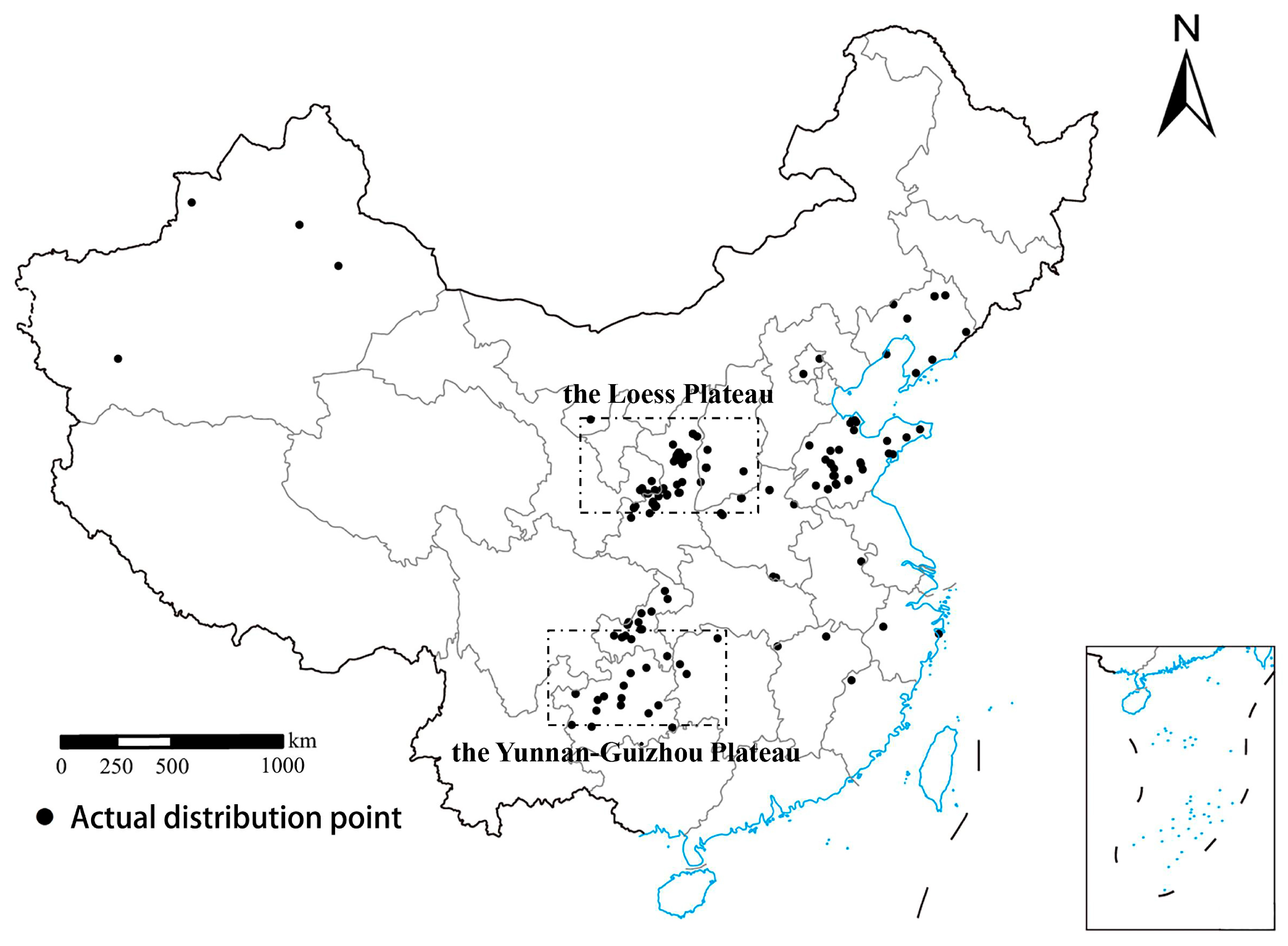
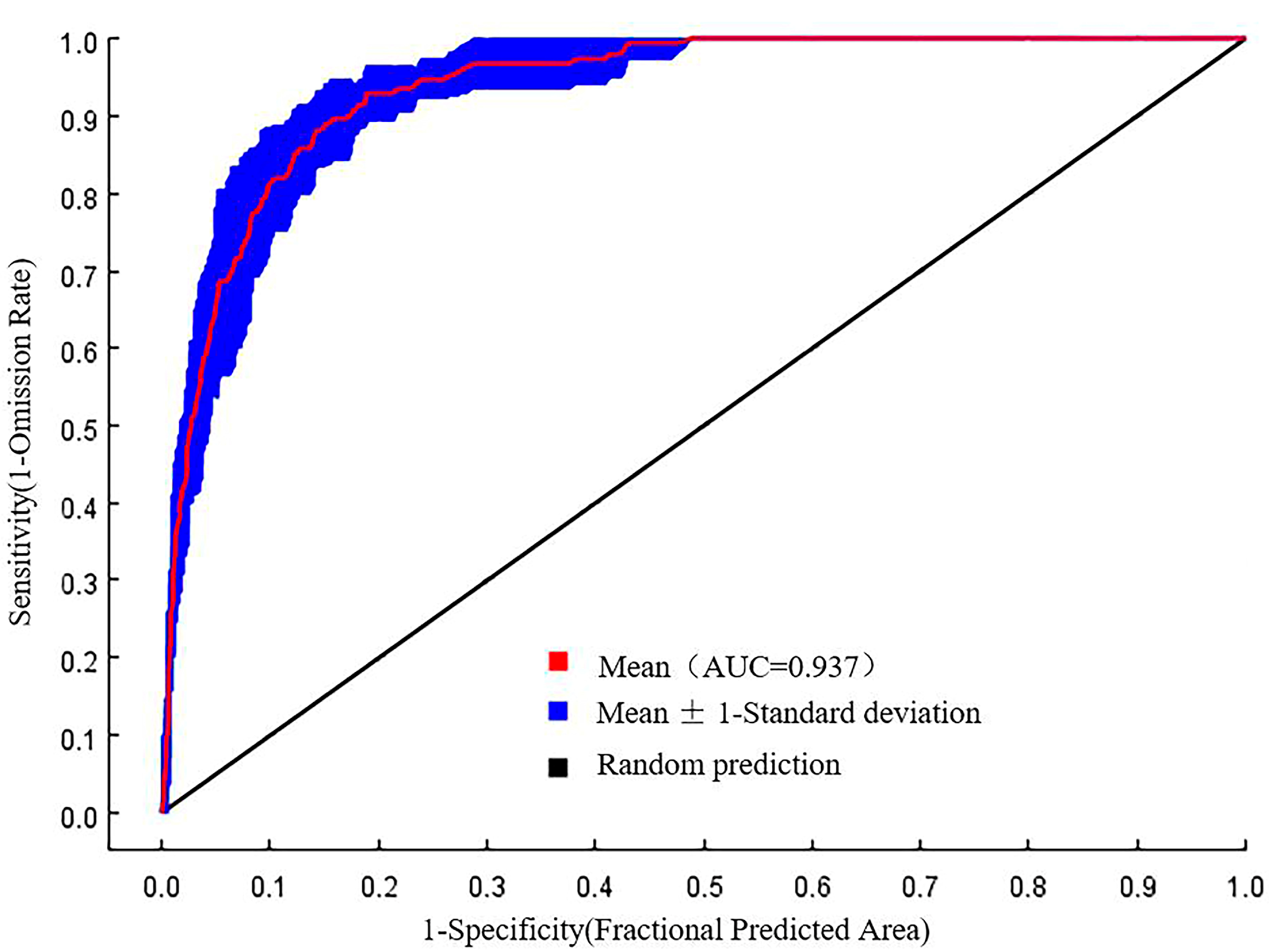
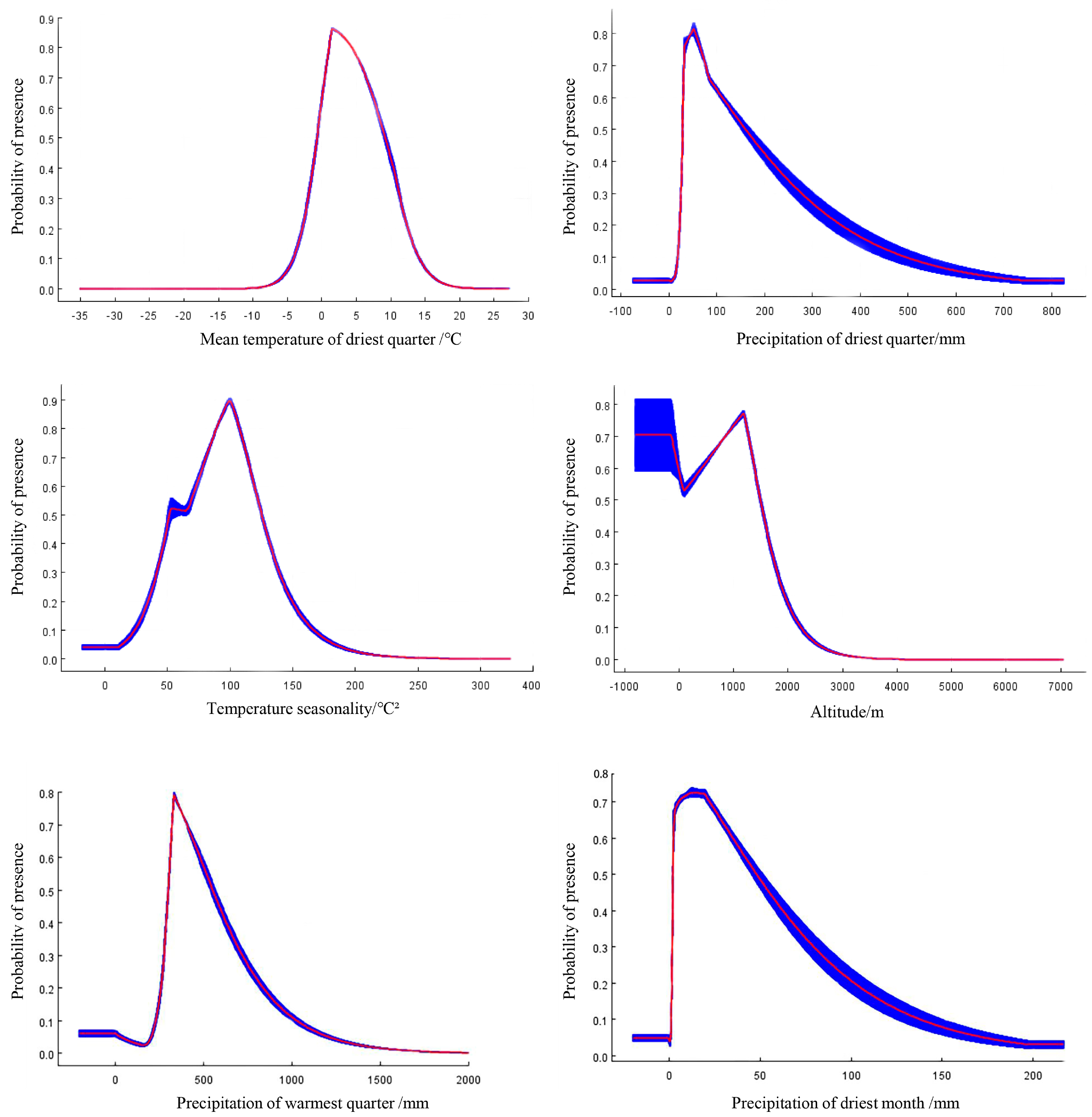
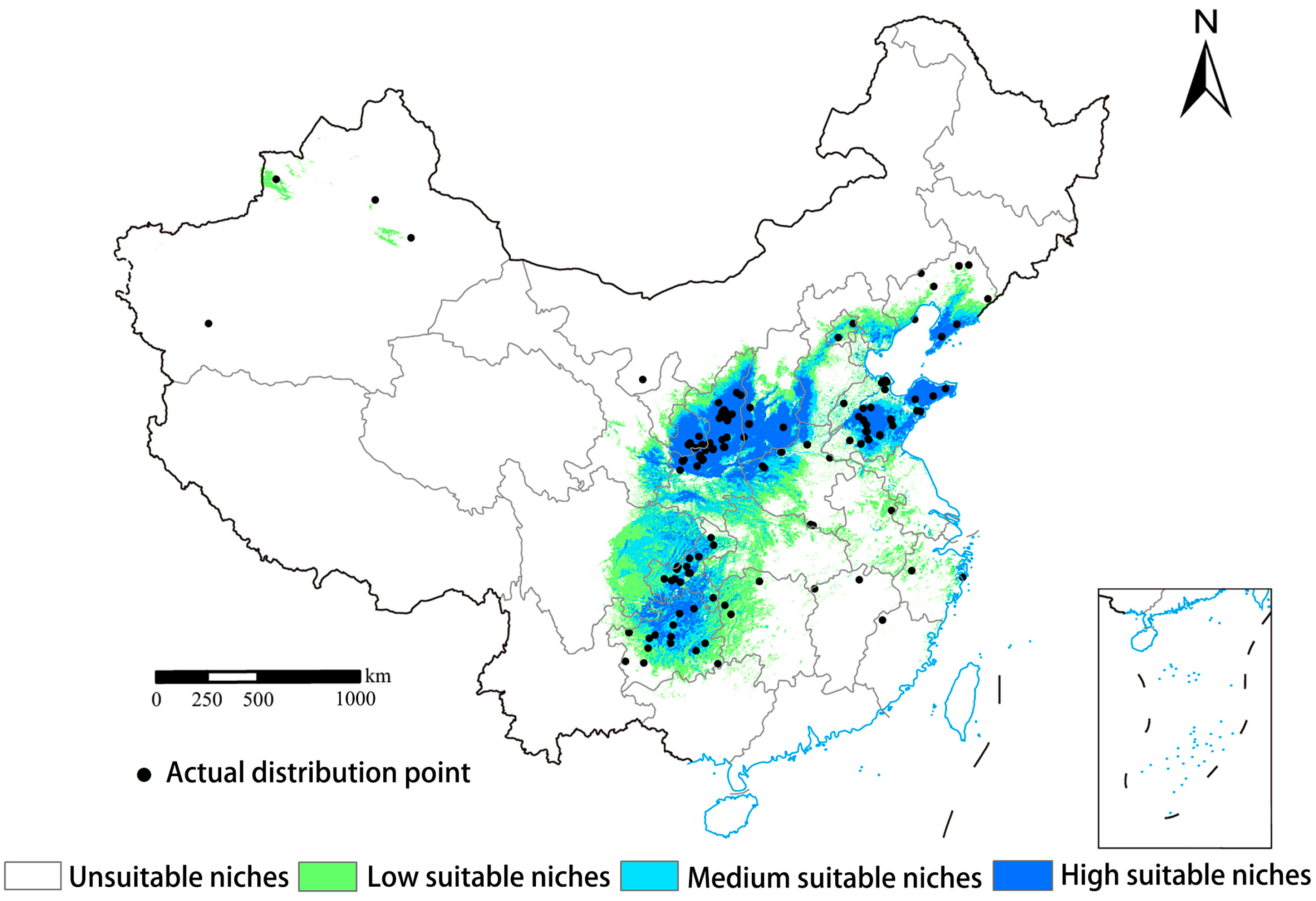



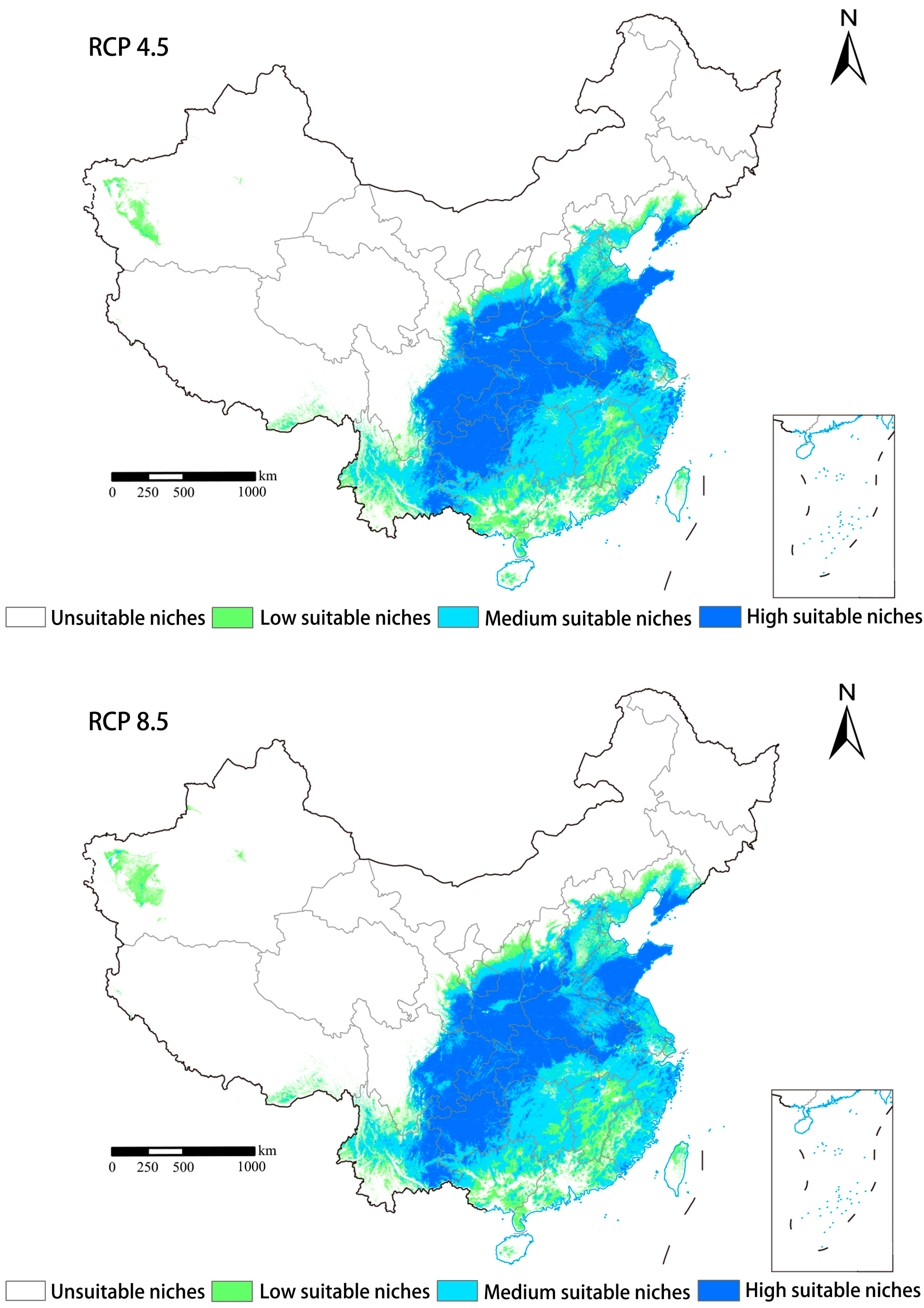
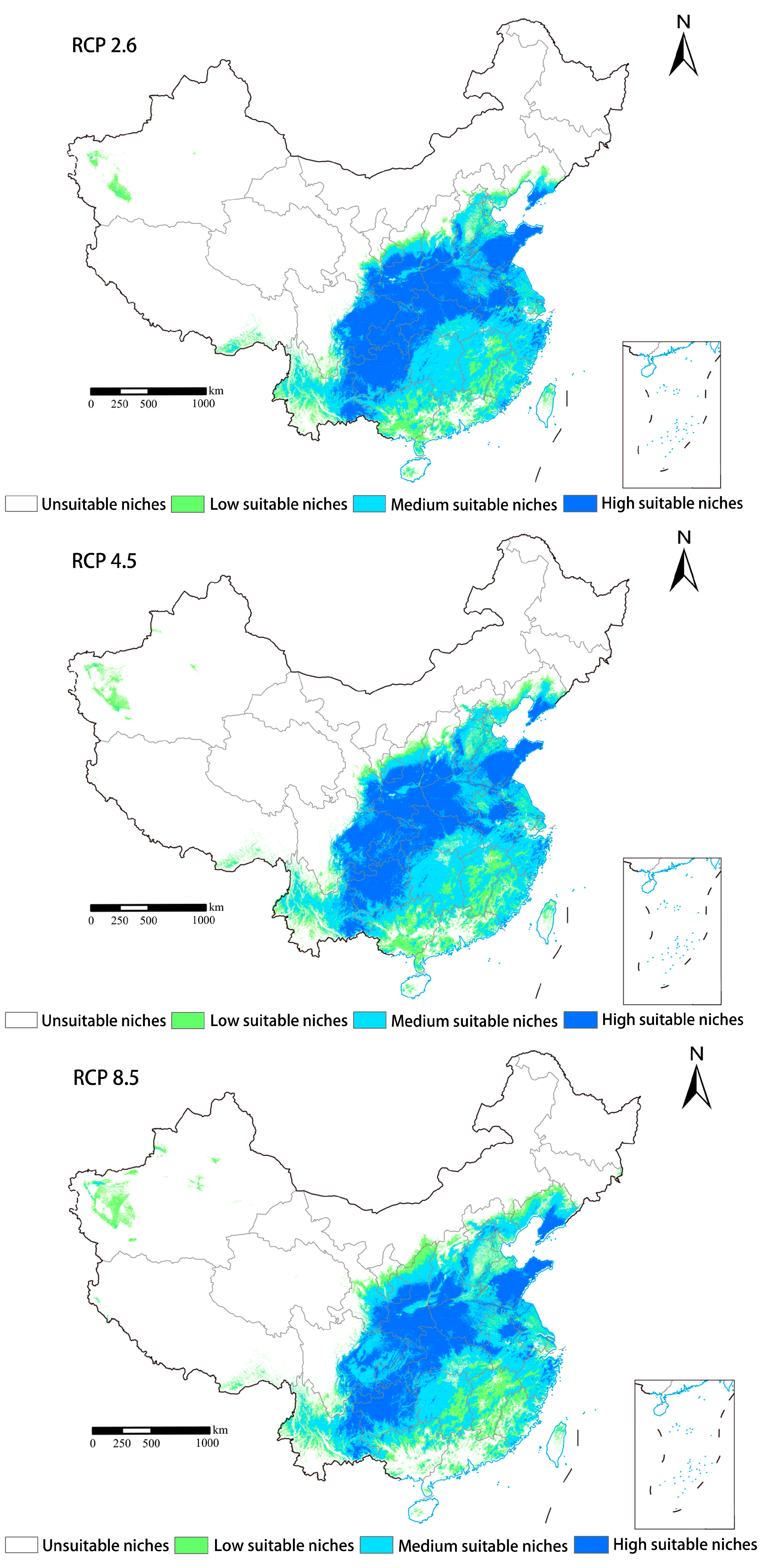
| Symbol | Environment Factors | Description |
|---|---|---|
| Bio1 | Annual mean temperature | |
| Bio2 | Mean monthly temperature range | |
| Bio3 | Isothermality | × 100 |
| Bio4 | Temperature seasonality | × 100 |
| Bio5 | Max temperature of warmest month | MAX(Tmax1, Tmax2, Tmax3, …, Tmax12) |
| Bio6 | Min temperature of coldest month | MIN(Tmin1,Tmin2,Tmin3, …, Tmin12) |
| Bio7 | Temperature annual range | bio5–bio6 |
| Bio8 | Mean temperature of wettest quarter | M [PM = MAX(P123, P456, P789, P101,112)] |
| Bio9 | Mean temperature of driest quarter | N [PN = MIN(P123, P456, P789, P101,112)] |
| Bio10 | Mean temperature of warmest quarter | MAX(123, 456, 789, 101,112) |
| Bio11 | Mean temperature of coldest quarter | MIN(123, 456, 789, 101,112) |
| Bio12 | Annual precipitation | |
| Bio13 | Precipitation of wettest month | MAX(P1, P2, P3, …, P12) |
| Bio14 | Precipitation of driest month | MIN(P1, P2, P3, …, P12) |
| Bio15 | Precipitation seasonality | × 100 |
| Bio16 | Precipitation of wettest quarter | MAX(P123, P456, P789, P101,112) |
| Bio17 | Precipitation of driest quarter | MIN(P123, P456, P789, P101,112) |
| Bio18 | Precipitation of warmest quarter | PW [TW = MAX(T123, T456, T789, T101,112)] |
| Bio19 | Precipitation of coldest quarter | PC [TC = MIN(T123, T456, T789, T101,112)] |
| altitude | Altitude | m |
| slope | Slope | ° |
| aspect | Aspect | —— |
| Environment Factor | Percent Contribution (%) | Cumulative Contribution (%) |
|---|---|---|
| Mean temperature of driest quarter | 28.3 | 84 |
| Precipitation of driest quarter | 19.5 | |
| Temperature seasonality | 12.2 | |
| Altitude | 8.9 | |
| Precipitation of warmest quarter | 7.9 | |
| Precipitation of driest month | 7.2 |
| Suitability | Current (1991–2020) | 1961–1990 | 1931–1960 |
|---|---|---|---|
| High | 59.75 | 74.36 | 52.26 |
| Medium | 35.37 | 32.78 | 20.30 |
| Low | 39.36 | 29.44 | 19.44 |
| Total area | 134.48 | 136.58 | 92.00 |
Disclaimer/Publisher’s Note: The statements, opinions and data contained in all publications are solely those of the individual author(s) and contributor(s) and not of MDPI and/or the editor(s). MDPI and/or the editor(s) disclaim responsibility for any injury to people or property resulting from any ideas, methods, instructions or products referred to in the content. |
© 2024 by the authors. Licensee MDPI, Basel, Switzerland. This article is an open access article distributed under the terms and conditions of the Creative Commons Attribution (CC BY) license (https://creativecommons.org/licenses/by/4.0/).
Share and Cite
Zhao, S.; Wang, H.; Liu, Y. Impact of Climate Change on Distribution of Suitable Niches for Black Locust (Robinia pseudoacacia L.) Plantation in China. Forests 2024, 15, 1616. https://doi.org/10.3390/f15091616
Zhao S, Wang H, Liu Y. Impact of Climate Change on Distribution of Suitable Niches for Black Locust (Robinia pseudoacacia L.) Plantation in China. Forests. 2024; 15(9):1616. https://doi.org/10.3390/f15091616
Chicago/Turabian StyleZhao, Shanchao, Hesong Wang, and Yang Liu. 2024. "Impact of Climate Change on Distribution of Suitable Niches for Black Locust (Robinia pseudoacacia L.) Plantation in China" Forests 15, no. 9: 1616. https://doi.org/10.3390/f15091616
APA StyleZhao, S., Wang, H., & Liu, Y. (2024). Impact of Climate Change on Distribution of Suitable Niches for Black Locust (Robinia pseudoacacia L.) Plantation in China. Forests, 15(9), 1616. https://doi.org/10.3390/f15091616




